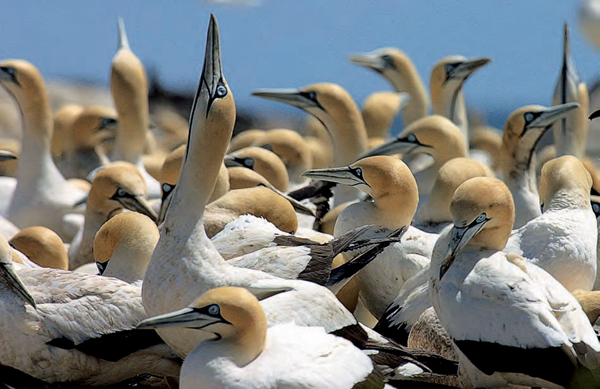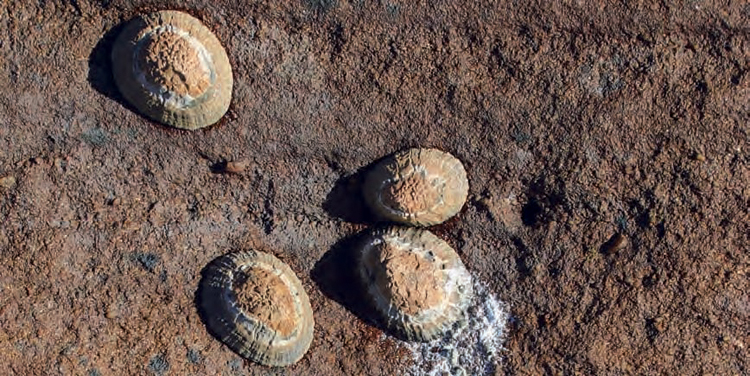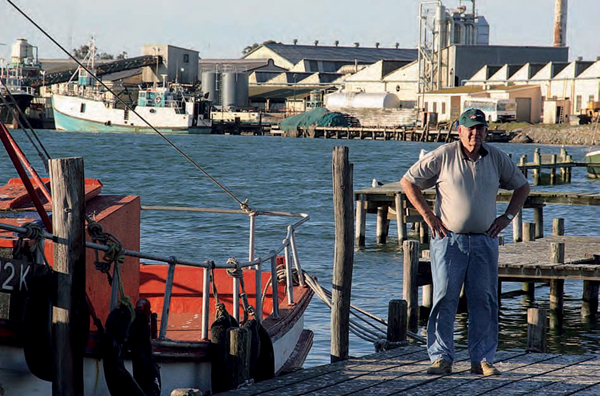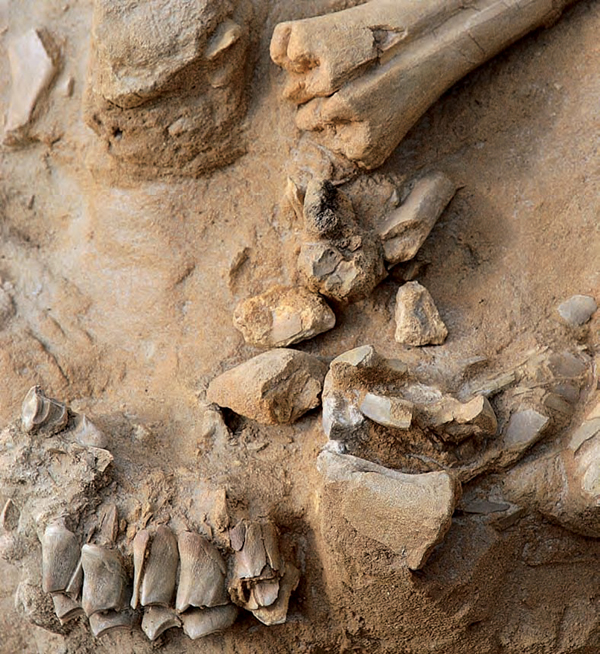

The well-appointed Heerenlogement, a watered cave used as a way-station by centuries of explorers.
The Heerenlogement (Gentleman’s Lodgings) is a seemingly obscure cave on the Trawal road between Doring Bay and Elands Bay. It was once the overland stopover of choice for adventurers, bandits, Cape government officials and miners travelling to and from the copper fields of the Richtersveld.
Very few people go there these days (although it is marked on reliable maps as a national monument), yet the graffiti on its exposed walls marks centuries of fabled names and explorations. An enormous rock fig grows in a fissure above head-height – legend has it that the fig has been here for centuries.
In the seventeenth century, the Heerenlogement offered a freshwater spring and grazing on the hill slopes. It could be guarded. From the mouth of the Heerenlogement you could see the Sandveld stretching far below.
The famous Oloff Bergh passed through here in 1682 en route to the north in his search for copper fields. He was the first to write his name on the walls.
Just more than a century later, the Heerenlogement saw its most flamboyant guest, in the form of naturalist and offbeat adventurer François Le Vaillant. The Frenchman arrived in full regalia, ostrich feather in his wide-brimmed hat, a baboon called Kees at his side and with a retinue of Khoi and their wagons.
They stayed there for a week, resting up for their venture north into the Richtersveld. Le Vaillant’s name is scratched on the inside wall of the cave, along with others such as Bergh’s and Andrew Geddes Bain’s.
The Heerenlogement is briefly referred to by most of the well-known travel writers going back in South Africa’s history. For us it was a personal pilgrimage to be there – but we wisely decided not to carve our names up on the wall. – Chris
The venerable graffiti left by old time travellers.

They bow to their mates and spend an extraordinary amount of time preening and nibbling one another’s feathers.
Gannets live in nests crowded together in dense colonies – a situation that calls for elaborate protocols, like sky-pointing.
A West Coast form of capital punishment, so the locals say, is to strap a sardine to the offending person’s forehead, tie his or her supine body to a raft and let the raft float out to sea. Before long, a gannet will come whistling down at terminal velocity and pierce the person’s skull with its powerful beak – presumably a quick death for both concerned.
Maybe it was the gannets’ loony-looking, pale blue eyes that prompted the old Dutch sailors to call these birds Mal Ganse (mad geese). Or maybe it was their reckless dives after sardines and other small fish (they swallow them underwater).
Sometimes so many dive on a shoal of sardines it looks as if they are being sucked out of the sky by a giant vacuum cleaner, as one writer has put it.
Gannets like to nest in dense (and smelly) settlements on certain islands, protected from mainland predators. But in such crowded surroundings, manners and neighbourliness are crucial. They bow to their mates and spend an extraordinary amount of time preening and nibbling one another’s feathers.
Whenever they want to fly, protocol demands they first signal their intentions for take off by sky-pointing – literally tipping their beaks right back before spreading their wings and taking off like kites if the wind is strong enough. If not, they waddle to an open corridor for a longer run, being pecked by carping neighbours as they go.
Bird Island (originally called Penguin Island) is connected to Lambert’s Bay by a causeway and is one of their favourite nesting places, with 11 000 breeding pairs (7 per cent of the global population of gannets).
In November 2005, though, young male Cape fur seals caused havoc in the colony by attacking nesting gannets and killing dozens of adults and chicks. After a series of attacks, some by night, the gannets abandoned the island en masse. It was unprecedented. Birders, tourists and town officials were horrified. But by July 2006, a few hundred gannets had returned in time for the breeding season in late September, and a marksman had been appointed to keep the delinquent seals at bay. – Julie

Limpets lead an intriguing life on the rocks of Elands Bay.
The West Coast specialises in eccentricities – and one of them can be found hanging from the ceiling of the bar of the Hotel Eland in Elands Bay.
It is a prosthetic leg with a Cape Stormers cap swinging jauntily from the toe.
“That belonged to a guy who used to drink here,” says Kurt Petzer, the barman, pouring us another round of Old Brown Sherry into agreeably large glasses.
“He ran a tab at the bar, and if he couldn’t pay up he’d leave his leg behind as surety and take himself home in his wheelchair. Unfortunately he died without settling his tab, so the leg still hangs there. I don’t know what a second-hand false leg is worth these days.”
The other peculiarity of Elands Bay is that, from time to time, West Coast rock lobsters stage walkouts here. They come ashore gasping for oxygen denied them by the rampant blooming of ocean algae – a gaudily hued phenomenon called red tide.
The most deadly red tide was in 1997. For a local fisherman legally allowed four tails a day, and only in season, it must have been excruciating to see 2 000 tons – the entire year’s commercial quota – arrive in this pathetic fashion. Massive front-end loaders hauled the dead, stinking lobsters away to be dumped.
In the summer of 2002, red tide struck again. This time about 1 200 tons of lobster came marching out, demanding oxygen. Environmental officers, policemen, the army and the navy were called in. They saved 100 tons of lobster, rushing the lobsters to commercial holding tanks or flying them by helicopter out to more aerated parts of the sea before they died of exposure.
How does blooming algae cause these mass walkouts? Ironically enough, it all comes from The Upwelling, that glorious, wind-driven process that forces nutrient-rich cold water up from the depths, and the phenomenon that makes the West Coast such a productive fishing ground. At times, however, diatom blooms are born. They literally consume all the oxygen in the water as they decay, leaving the local crayfish population very short of breath.
The Sandveld should be one of South Africa’s major tourist attractions – lobsters by the thousand, delightfully eccentric locals, a left-hand wave surfers might kill for, and exquisite scenery. But something is worrying the locals – the words “potatoes” and “water” keep coming up.
We find the potato farmers holding a convention in the Hotel Eland. The day’s business over, the farmers are in the bar, in the midst of Happy Hour. But they don’t seem very happy.
Verlorenvlei, a wetland of international importance, between the Piketberg and the sea.
Later we discover why. In some places up here in the semi-desert Sandveld, the water table has dropped by as much as 14 metres and is below sea level. This means salt is being drawn through the soil and is turning the borehole water brackish.
By 2005 the Verlorenvlei – the most promine nt wetland in the area – was in trouble. Water levels were sinking. The reason? Over-extraction of water by potato farmers.
An interviewee in an article in the Cape Times in May 2005 remarked that it was like “exporting water inside potato peels”.
“Everyone is losing,” says Rina Theron, Potato Farmer of the Year (2000). “The water and the Sandveld are vanishing, the farmers are struggling, retailers are forcing us to accept prices below production cost and the middlemen are ripping off consumers.”
Even the potatoes themselves are losing. They have become prey to half a dozen malicious viruses.
“My fellow farmers fail to see the problems for what they are,” Rina adds, when we contact her later. “When the water quality and quantity decline, they just say ‘Next winter the rains will be ample and the boreholes will fill up again’. It’s gone beyond that now. We need to work on a holistic solution – farmers need to plant fewer potatoes for a better price.”
The next day we set out on a more cheering mission – to find the warbler Lawrence Green said was named for François Le Vaillant. The French explorer of the late 1700s played here when this was a true sanctuary for birds.
Said Le Vaillant: “Verloren Vlei [sic] is the only place for an ornithologist to fix his residence who would wish in a short time to procure a complete collection of the web-footed and shore birds of Africa.”
We listen for the chirrupy song of the bird named after him (it’s now called the lesser swamp-warbler), but the noise from all the coots, dabchicks, avocets and grebes drowns it out.
So we stand without speaking, wondering how it must have been three hundred years ago, before the lobster rush, before the first planted potatoes, before bars where false legs were considered legal tender.
There is a scent of the old magic still here. It’s in the rearing shadow of the distant Piketberg, in the huge blue gums and old, reed-thatched houses of the Sandveld, in the tang of the sea overlaying the grace of vlei and water lilies – somewhere among the thousands of muttering, warbling, clucking, whistling, bleating birds. – Julie
A grey heron in breeding plumage patrols the shallows of Verlorenvlei for small, unwary fish.
All the charm of the West Coast: lobster traps, bright flowers and the nearby crash of icy waves on a white beach.

Retired skipper René Zamudio has settled on the banks of the Berg River, in sight of his former trawler, the Aranos
Laaiplek, on the Berg River, is where fishing trawlers, sailors and large black birds come to rest at night. On a summer’s evening, cool breezes dart down from the sea, with battalions of cormorants riding their coat-tails en route to nesting sites.
“Ah, you must be here for the Stephan story,” says our host at the Harbour Lights self-catering. René Zamudio is a tall man of seventy years, with eyes that constantly scan the horizon in the way of a retired skipper.
Stephan? We have no clue what the man is on about. So we sit on the stoep outside our room and talk. Just in front of us is moored a small crayfish boat, with rafts of seabirds lazing on the jetties. Upriver lies the port, with all its fishing boats. Above us wheel gulls and terns, with pied kingfishers hovering on blurred wings over the water. We skip nearly two centuries back in time.
The Stephan family, originally from Germany, arrived in South Africa and soon began trading with the farmers of the desolate West Coast. In exchange for grain and fish, they shipped in all manner of supplies for the isolated farming community. The “Great Bank of Agulhas” off the West Coast was a treasury of sea life. In those days, penguin eggs were “three bob to the hundred” and crayfish were abundant and used only for bait.
How tastes have changed. Nowadays, penguin tourism is more lucrative than penguin cuisine. But a crayfish is another story, with some upmarket restaurants charging R200 a tail.
René, whose father was also a skipper in these parts, has been compiling research on the enterprising Stephans. He has uncovered some poignant events that took place between here and St Helena Bay and Paternoster, which has become a favourite weekend hideaway for Capetonians.
A typical West Coast kitchen from decades ago – in Die Winkel op Paternoster.
Left Salted mullets (harders) drying in the sun before becoming bokkoms (fish biltong). Laaiplek is the epicentre of this West Coast industry.
Right A pelican enquires politely about leftover mullets for breakfast.
The most interesting character in the Stephan clan turns out to be Oom Carel Stephan, born in 1843. As a young buck he fell in love with Marie Rochier, whose parents farmed near the Berg River. They disapproved of Carel and would not give their permission for a marriage. So Marie drowned herself in the farm dam.
On that day, the heartbroken Carel swore he would never marry. He bought a condemned French barque, towed it to the mouth of the Berg River and made it his fortress, warehouse and home. From there he traded and managed the Stephan empire, seldom socialising. He ruled his workforce like the Godfather and called them “My Kinders” (My Children).
Like the pirate captains one reads about in the old adventure books, Oom Carel kept a much-beloved parrot. When the parrot died, he ordered a tiny coffin for the bird. He instructed all his clerks to attend the funeral. The local missionary, also a beneficiary of Oom Carel, had to read the formal service, almost as if the parrot had been a human family member.
Oom Carel used a Khoi runner called Piet Danster to relay messages. Piet carried a little whip, which he would use on himself when he felt he was slowing down on the run. He would go on 80-kilometre runs regularly, cheerfully negotiating the routes between Stompneus Bay, Lambert’s Bay, Hopefield and Saldanha Bay.
Then came the Anglo-Boer War, and Boer general Manie Maritz rampaged up and down the West Coast with his flying commando. They helped themselves to stores from the French barque, made their way north to Lambert’s Bay and fired a couple of shots at a British gunboat. This was to be the one and only “naval engagement” of the Anglo-Boer War.
At nearby Vredenburg, the Boers looted shops and came away with knives, sweets and savouries. Then they hit the local hotel. One of the commandos got so jolly they had to leave him behind under the bar counter.
The Stephans had a store in Vredenburg. The cash from the store was hidden in a special hole in the pulpit of the local church. No one thought to look there. Oom Carel, meanwhile, decided to sandbag his ship in anticipation of future Boer attacks. Unfortunately, all that weight broke the old ship’s back, and she sank into shallow mud. Oom Carel, one presumes, took up new lodgings on dry ground.

The Somerset West Photographic Club stalking Paternoster’s picturesque coast for postcard images.
René Zamudio’s family hails from the French–Spanish borderlands. His father worked for the Stephan Brothers and did most of his salvage operations in a boat called Luna.
When the Portuguese mailboat Lisboa went down on 24 October 1910 near Paternoster, it was René’s father who went to its rescue with the Luna. All 250 passengers survived and three crewmen drowned. The cargo consisted of barrels of olive oil, red wine and a number of fighting bulls, destined for the arenas of Lourenço Marques. Even the bulls were brought ashore, and they no doubt strengthened the bovine gene pool of the West Coast over the decades to come.
The wine, however, had another outcome. The men of Paternoster’s Italian fishing community went to “check up” on the wine barrels that had washed ashore. After the fishermen’s week-long absence, their wives went to look for them. The women found them in a cave, where they’d befriended the casks of hearty Portuguese red.
René himself has had a colourful history at sea. He is regarded as a pioneer in the pelagic fishing industry. He has fished all over the world, from Guinea Bissau to Morocco to Australia to the North-east Atlantic. But it’s the West Coast René loves.
“Now,” he says. “Would you like to try some bokkoms?”
He is referring to fish biltong made from harders, the staple of workers from here to Mauritius – we have to have some. So off we troop to Bokkoms Lane, the centre of the fish-biltong industry. Oom Paul Marais from Sonskyn Visserye tells us he sells his bokkoms all over South Africa. My personal opinion of fish biltong? It goes down a treat with about four shots of Jack Daniel’s. – Chris

Archaeologists have uncovered fossils of an ancient African bear, short-necked giraffes and other strange beasts at what is now the West Coast Fossil Park.
Left The West Coast National Park protects several species of threatened tortoises.
Right Saldanha has become a busy seaport.
Five million years ago, the Berg River flowed through what is now Langebaan. It was a massive, powerful river, and its flow washed the bones of ancient creatures down with it. They collected in phosphate deposits and slowly, cell by cell, became stone.
At what is now the West Coast Fossil Park, researchers have found the fossils of an ancient African bear, short-necked giraffes (sivatheres), sabretoothed cats, three-toed horses, two extinct species of elephant, a giant ostrich and the megatooth shark, plus vast amounts of tiny bones belonging to frogs, chameleons, moles and fish.
The first little hominins, ancient ancestors of humans, were already present, hunting and being hunted.
Fast-forward to a more modern time, only 117 000 years ago. A young woman walking across a rain-wet dune left her tiny footprints in the sand. She was just over 1.2 metres high, and seemed to have been burdened by something, perhaps a small animal she was bringing back to her tribe. Not long after she walked by, sand covered up her footprints again, and slowly, ever so slowly, became compressed by more layers above, and turned to stone, protecting the unseen.
But, many thousands of years later, erosion caused the layers to split and break, and the little woman’s footprints were exposed. Geologist Dave Roberts discovered them in 1995, and anthropologists such as Dr Lee Berger confirmed they belonged to an anatomically modern human, a female they called Eve. To safeguard them, the US-based National Geographic Society funded the removal of a large slab of rock with their imprints, and they are now at the Iziko Museum in Cape Town. One day they will be displayed near where they were found, at Kraal Bay in the West Coast National Park.
Not far away, at Elands Bay, is a cave with rock paintings made about 20 000 years ago, some of the first human art.
Now, of course, humans walk heavily on the Earth. There are towns, holiday homes, a pseudo-Greek resort, a nuclear power station called Koeberg, and a cream and rose-pink industrial complex called Saldanha Steel, the endpoint of the 861-kilometre Sishen–Saldanha railway line, its ultra-long trains bearing red iron ore to be turned into burnished metal. – Julie
When water dries up inland, flamingos head for the West Coast’s saline estuaries and wetlands. Flamingos are so singular that taxonomists have classified them in a family of their own.
What a strange creature is a flamingo. To this day, taxonomists are uneasy about how it should be classified. It has the elongated posture of a heron or stork, but the webbed feet, courtship behaviour and parasites of a wildfowl. And a few quirks all its own.
For example, flamingos put on communal displays, but are not territorial. They seem to thrive in water so caustic it rivals household detergents, or in estuaries and pans two or three times more saline than the sea. Even the flamingo diet is a little odd – they dine on blue-green algae, small seeds, diatoms and whatever little invertebrates they can scare up by twiddling their toes in the mud. Sometimes they’ll stand for hours on one leg, with the other tucked up under the belly and their heads lying across their backs as if their necks were broken. So singular are these birds that biologists have simply given them their own taxonomic family – Phoenicopteriformes.
Flamingos are at their most bizarre when in a group, indulging in their synchronised rituals of preening and stretching, a bit like a troupe of skinny ballet dancers warming up. They wag their heads like flags while making loud honking noises. They briefly salute the world in unison with their bright pink wings, making low-pitched grunts. With little or no provocation, an evenly spaced group will march off through the water in one direction, and then tramp back.
The Ancient Egyptians thought flamingos were the embodiment of the sun god Ra. The Romans ate them, and thought their fleshy, bristled tongues particularly delicious.
In South Africa, you’ll find lesser and greater flamingos at dams great and small. But when these dry up, the flamingos head for the West Coast in huge numbers, and every estuary or lagoon seems to have a pink flock fossicking in the shallows. – Julie
